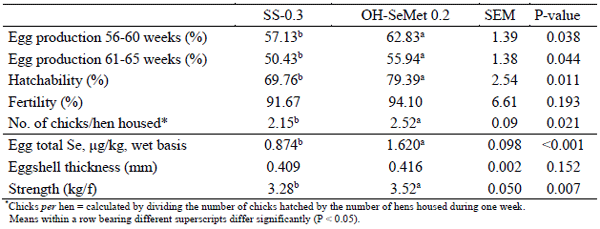I. INTRODUCTION
Broiler breeders require adequate levels of nutrients to reach their genetic potential in terms of productive and reproductive performance, and to transfer essential nutrients from eggs to embryo for the development of chicks (Rajashree et al., 2014).
It is known that oxidative stress impairs a breeder’s performance (particularly related to aging) and embryo development. This suggests that enhanced antioxidant defenses, via effective dietary supplementation with antioxidants, can better ensure and uphold productivity, fertility and hatchability.
Among different dietary antioxidants, Selenium (Se), functioning through various selenoproteins, plays a pivotal role in the antioxidant defense system. In fact, it has been proven that Se can prevent lipid peroxidation and maintain quality of semen and ensure fertility of a breeding flock (Surai and Fisinin, 2014). Moreover, Se status in the eggs from breeding hens is of great importance for maintenance of the antioxidant system of the developing embryo, resulting in higher hatchability and quality of day-old chicks. Therefore, dietary Se supplementation is widely practiced, using either an inorganic form such as sodium selenite (SS) or organic forms like Se-yeasts or pure selenomethionine (SeMet) products.
Hydroxy-selenomethionine (OH-SeMet) is a chemically synthesized molecule and has been proven to be highly efficient in transferring Se from diet to eggs compared with SS or Seyeast products, and to enhance poultry performance, particularly during critical periods of the production cycle (Jlali et al. 2014; Michiels et al., 2019; Surai et al., 2018).
The aim of this study was to compare the effect of OH-SeMet and SS on performance and egg quality of a breeder flock, and the growth performance of their progeny.
II. MATERIALS AND METHODS
A total of 216 broiler breeders (AP95 Aviagen) from 56 to 65 weeks old were randomly assigned to two dietary treatments (27 replicates; 4 hens each). Hens were fed on the same basal diet with the only difference being the Se source used: either SS at 0.3 ppm or OH-SeMet at 0.2 ppm. Egg production was recorded during two cycles of 35 days, and egg weight, egg breaking strength, Se deposition in the whole egg were determined. Fertility, hatchability, embryonic mortality and number of chicks born per hen housed were also measured. At the age of week 65, hens were inseminated using 3-cocks-semen pools (0.5 mL of fresh semen to ensure a concentration of 100 × 106 spermatozoa/mL) and repeated after 3 days and their eggs were collected for ten days after the last insemination. The eggs were incubated and transferred for hatching at day 18, the day old chicks were counted and selected and used for the growth performance trial.
A total of 520 mixed progeny chicks were allocated in a completely randomized 2 x 2 factorial design: 2 sources of Se for broiler breeders’ diets and 2 sources of Se for progeny diets – SS at 0.3 ppm or OH-SeMet at 0.2 ppm (Table 1). The 4 treatments were replicated 13 times (10 birds each) and the birds were reared until 42 days. Body weight, average weight gain, average feed intake and feed conversion ratio were determined per pen for the overall experimental period.
Table 1 - Experiment: completely randomized 2 x 2 factorial design.
For the breeder trial, data were analyzed by general linear model (GLM) using as a fixed effect the source of selenium used in the diet. For the progeny trial, data were analyzed by general linear model (GLM) in a 2 x 2 completely randomized factorial design using as fixed effects the breeder diet and the progeny diet. Means were compared by Tukey’s test at a 5% probability levels (SAS, 2011).
III. RESULTS AND DISCUSSION
Table 2 shows breeder performance and egg quality. In both production cycles evaluated, dietary administration of OH-SeMet at 0.2 ppm increased egg production by 10% compared to SS at 0.3 ppm (P = 0.038 and P = 0.044, respectively). These results are in agreement with the findings of Brito et al. (2019) who showed dietary supplementation with OH-SeMet enhanced egg production in laying hens from 50 to 70 weeks of age more efficiently as compared to SS. In fact, it is well established that oxidative stress is an important factor of aging (Dunn, 2013). As the hens age, they steadily decrease productivity and eggshell quality. Compared with SS, OH-SeMet can better maintain egg production after 56 weeks of age.
Eggs from hens receiving OH-SeMet showed higher Se content (P < 0.001) than the SS group. This result is consistent with the finding of Jlali et al. (2013) who reported that a half dose of OH-SeMet delivers significantly higher Se level in eggs compared with SS.
Table 2 - Performance and egg quality of breeders fed on Sodium Selenite (SS) or OH-SeMet (SO).
No difference was observed in eggshell thickness. However, OH-SeMet at 0.2 ppm increased eggshell strength as compared with SS (P = 0.007). This finding supports Brito et al. (2019) who reported OH-SeMet improved eggshell breaking strength, and assumed that improved eggshell quality may be related to more Se deposited in the shell and shell membrane that strengthens the shell. In fact, Se participates in the formation of the eggshell organic matrix and the highest Se concentration is detected in the shell membrane. Se level in the shell is comparable to that found in albumen (Golubkina and Papazyan, 2006).
The high content of Se in eggs of breeders receiving OH-SeMet improved hatchability of fertile eggs and the number of chicks per hen housed, as there was a 13.8% and 17.2% increases as compared to the SS group, respectively (P = 0.011 and P = 0.021). It is known that the incubation process causes oxidative stress. More Se deposition in the eggs from hens receiving OH-SeMet may have contributed to the increased antioxidant defense of the embryo due to higher selenoprotein expression and activity, leading to increase in hatchability (Surai and Fisinin, 2014). For fertility, no difference was observed between the two Se sources.
The growth performance (1-42 days) of the progeny trial is summarized in Table 3. No interactions (P > 0.05) were detected between the two breeder diets and progeny diets in any criteria measured. No statistical difference was found between the two Se sources for feed intake and weight gain. However, the Se sources in the breeder diet showed a significant effect on the feed conversion ratio of the progeny; the chicks from breeders receiving OH-SeMet showed significantly better FCR than the birds from breeders receiving SS (-8.4 FCR points; P = 0.017). These results suggest long-lasting maternal effects of the OH-SeMet that may be attributable to more Se deposited in the day-old chicks, leading to a better start and subsequently better performance. Similar findings have been reported by Sun et al. (2012) who observed a significant increase in body weight gain and feed efficiency in chickens from breeders fed on organic mineral diets.
Table 3 - Effects of dietary Se source for breeder and/or progeny on broiler performance (1-42 d).
For the progeny diet effect, no statistical differences were observed between the two Se sources despite OH-SeMet-fed broilers having 4.2 FCR points lower (P = 0.217). This result appears to be logical in that there was no major challenge to the birds during the trial. In fact, it is well established that the benefits of organic Se (namely SeMet) deposited in animals’ tissue show up when birds face stressful situations. When SeMet is supplemented, more Se stored in tissues will enable birds to produce antioxidant enzymes, when feed intake drops and/or the Se requirement rises, as an effective means to ensure their metabolic needs thus growth performance.
IV. CONCLUSION
Overall, for an aged broiler breeder flock, dietary supplementation with OH-SeMet at 0.2 ppm significantly improved production, eggshell strength and hatchability, compared with SS at 0.3 ppm, which can be an effective approach to help birds maintain and prolong productive and reproductive performance when the breeder flock ages. The maternal supplementation with OH-SeMet shows a positive impact on their progeny, in terms of feed efficiency.
Presented at the 31th Annual Australian Poultry Science Symposium 2020. For information on the next edition, click here. 













.jpg&w=3840&q=75)